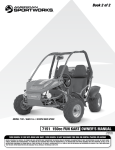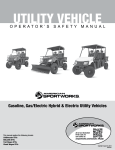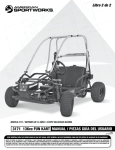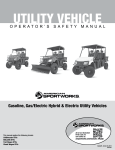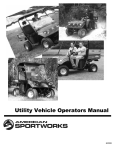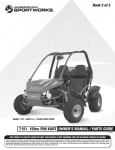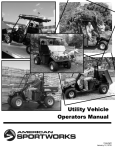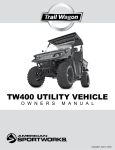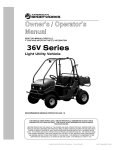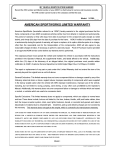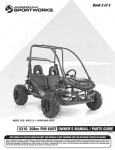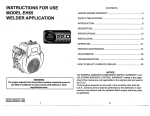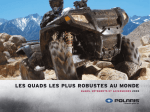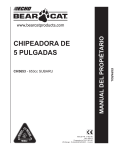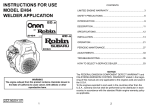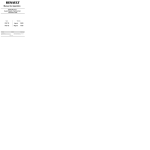Download American Sportworks Chuck Wagon Operator`s manual
Transcript
SECTION 1 American SportWorks welcomes you to its growing family of new product owners. This Utility Vehicle “UTV” is a light utility vehicle that has been designed with care and built by skilled workers using quality materials. Proper set-up, maintenance and safe operating practices will help you get years of satisfactory use from this vehicle. Safety First American SportWorks is fully aware of the need for safe operating procedures around all of our equipment. We hope you will make a sincere effort to put safety above all other priorities. The Utility Vehicle was designed and built for work, recreation, and enjoyment; however, improper and irresponsible operation could result in serious injury or death. Since this is an off-road vehicle, operators will seldom see the road safety and warning signs they are accustomed to seeing on highways and public streets. This places additional responsibility on the driver to operate this vehicle well within the safe operational limits and capabilities of the unit. This manual has been prepared to instruct you in the safe and responsible operation of your Utility Vehicle. Read and abide by all safety alert information about this vehicle. If you do not understand any part of this manual, contact your local dealer for additional information and clarification. As the operator of this piece of equipment, you are in complete control. Only you can prevent an accident from happening. Using This Manual • Prior to any vehicle operation it is absolutely essential that you read and comprehend each section in this manual to develop an understanding of your vehicle and for your safety. After reviewing this manual, store it in a dry and easily accessible place for future reference. introduction Terminology Right-hand and left-hand as used in this manual are determined by facing the direction the vehicle will travel while in use unless otherwise stated. Getting Acquainted with your Utility Vehicle This utility vehicle is designed exclusively for off-road use. It is not designed, properly equipped, or licensed to be safely operated on public streets and highways unless equipped with an LSV package. An ASW Low Speed Vehicle (LSV) is street legal where allowed when properly licensed and plated. Although street legal, the LSV is not designed for, nor allowed on highways. Refer to your local ordinances regarding the use of Low Speed Vehicles in your area. Unlike an ATV’s one person “straddle saddle” seat, the Utility Vehicle sports dual headrests, cushioned seats with seat belts and a protective full length body. Two passengers can ride comfortably in this vehicle protected from splashing water and mud. The Brush Guard mounted to the vehicle’s frame provides protection against low hanging limbs and briars. The Brush Guard also provides a mounting system for American SportWorks optional windshields, canopy tops and weather enclosures. It also serves as a mounting base for many other optional accessories. The cargo bed is for transporting accessories such as camping equipment, tree stands, hunting gear, and fishing gear. A standard hitch mounting plate enables quick installation of a rear hitch for pulling small trailers full of supplies, tools, gear, and game. Please visit our website at www.amsportworks.com for a full list of available accessories. • The Operator’s Section is designed to help familiarize you with safety, assembly, operation, adjustments, troubleshooting, and maintenance. Read this manual and follow the recommendations to help ensure safe and efficient operation. • The information contained within this manual was current at the time of printing. Some parts may change slightly to assure you of the best performance. • To order a new Operator’s or Parts Manual contact your authorized dealer or contact American SportWorks Customer Service at 800-6437332 or visit us on the web at www.amsportworks.com. 4 15571R1 Rev. A pub. 04/16/2015 introduction The Utility Vehicle has some similarities to an ATV. Your Utility Vehicle has a short wheelbase, narrow stance, and high center clearance all which provide for narrow and difficult trail access. This combination also enables this vehicle to be loaded in the back of most full to midsized pickups for transport. SECTION 1 Always use the serial and model number when ordering parts for your Utility Vehicle. The serial-number plate is located under the cargo bed on the driver’s side just above the engine, on the frame as shown in figure 1 below. The Utility Vehicle’s ground compaction and is very gentle on the ground and surrounding vegetation. The engine is EPA certified and will meet California Air Resources Board (CARB) certification standards, when so equipped. Owner Assistance The parts on your Utility Vehicle have been specially designed and should only be replaced with genuine American SportWorks parts. If customer service or repair parts are required contact an American SportWorks dealer or our customer service department toll free at 800643-7332 or by email at [email protected]. Our dealers have trained personnel, genuine repair parts and equipment specially designed to repair American SportWorks products. Fig. 1 Serial Number Plate Location Record your Utility Vehicle Model, VIN and Serial Number here for quick reference: The model and vehicle identification number (VIN) are located in the cab under the steering column / the serial number is located under the dump bed (see figure 1) MODEL: VIN: SERIAL NUMBER: American SportWorks wants you to be satisfied with your new vehicle. If you do not understand any part of this manual or you’re not satisfied with the service received, please take the following actions: 7625 DiSalle Boulevard Fort Wayne IN 46825 • Discuss the matter with your dealership service manager. Make sure they are aware of any problems so they can assist you. 62194 Commercial Street Roseland, LA 70456 • If you are still unsatisfied, please call American SportWorks customer service at 800-643-7332 or email us at [email protected]. Toll Free 800-643-7332 • Fax 800-399-1399 www.amsportworks.com 15571R1 Rev. A pub. 04/16/2015 5 SECTION 2 safety Read These Important Rules for Safe Operation NOTE The Operator, Passenger, Parent or Guardian must read, study and understand all the items contained within this operator’s manual before operating the Utility Vehicle. Failure to follow these instructions could endanger the personal safety of the Operator, Passenger and any Bystanders. Recommended minimum age of operator is 16 years of age. Close adult supervision is required at all times! Pay close attention to all Caution and Warning labels located on the Utility Vehicle CAUTION Transporting vehicle at a high rate of speed may cause damage to component parts. When transporting any utility vehicle with an installed windshield or roof DO NOT travel at high speeds! Assumption Of Risk: The owner or operator assumes all the risks incident to or arising out of the operation of this Utility Vehicle FAILURE TO FOLLOW AND COMPLY WITH ALL WARNINGS MAY CAUSE SERIOUS INJURY OR DEATH SOME WORDS ABOUT SAFETY The following pages present important information and recommendations to help you drive your vehicle safely. Please read through these pages thoroughly. WARNINGS AND CAUTIONS ! This is the safety alert symbol. When you see this symbol on your machine or in this manual, be alert to the potential for personal injury. Read and follow all instructions in this Operator’s Safety Manual, Owners Manual / Parts Guide and any accompanying manuals before attempting to operate this vehicle. ! WARNING Indicates a potential hazard that could result in severe personal injury or death ! CAUTION Indicates a potential hazard which may result in personal injury or damage to the machine. NOTE 6 will alert you to key information or instructions. Before operating this vehicle The owner, and each operator, must understand that this vehicle was not designed or manufactured to meet specifications for use on public roads, streets, highways and thoroughfares. The owner, operator(s) and passenger(s) must read and understand all the instructions for proper assembly and safe operation, as well as the instructions concerning the engine and all other portions of the vehicle as described and illustrated in this manual. Children must be of the specified age or older and supervised by an adult at all times when using the vehicle. This vehicle is not a toy. Cell Phone Use The use of Mobile Communications Equipment has become increasingly important and prevalent in both personal and business affairs. Drivers must not compromise their own, or others safety when using such equipment. ASW recommends against the use of any handheld device while driving this vehicle. We hope you will have a fun, safe experience with our products and thank you again for choosing an American SportWorks utility vehicle. 15571R1 Rev. A pub. 04/16/2015 SECTION 2 safety It is very important to read, understand, and follow all instructions and warnings located on the decals on your Utility Vehicle. WARNING Failure to understand and follow Warnings and Instructions for the safe use and maintenance of this product may result in Death or Injury! This information is contained in the Warning Labels, Owner’s Manual & Supplements, Safety Video, and Engine Manual supplied with this product. Make sure that you understand and follow all Warnings and understand and follow all Warnings and Instructions in this Instructions in this material. • Always wear a D.O.T.-approved motorcycle helmet, eye UNDER protection, and protective clothing. • Reduce speed and use caution on slopes and in sharp turns. AGE • This vehicle is not to be operated by anyone under 16 years of age. • Do NOT operate the vehicle without the brush bars securely in place. • Keep all covers and shields properly installed. • Never ride after consuming alcohol, drugs, or other intoxicants. • Throttle and Brake Controls must work properly and freely before starting the engine. • Operator must be seated, safety belt must be fastened before operating the vehicle. • Never operate at speeds too fast for your skills or the conditions. Never attempt jumps or other stunts. • Check tire pressures before operating. Refer to Owner’s Manual for proper operating pressure. • This vehicle is not street legal and is intended for off-road use only. If you did not receive any of the material listed above,please call 800-643-7332 and request to have them sent to you at no charge. SIEMPRE USE CINTURON DE SEGURIDAD El cinturón de seguridad debe ser apropiadamente atado y ajustado para cada ocupante antes de la operación del vehículo; Ver Manual de Dueño. HOT SURFACES SUPERFICIES CALIENTES Surfaces around the engine and exhaust can be extremely hot. Allow surfaces to cool before servicing. Las superficies alrededor del motor y el escape pueden estar extremadamente calientes. Permita que las superficies se enfríen antes de realizar el mantenimiento. WARNING El hecho de no comprender y seguir las Advertencias y Instrucciones para el uso seguro y el mantenimiento de este producto puede causar ¡MUERTE O LESION!. Esta información esta contenida en las Etiquetas de Advertencia, Manual de Dueño y Suplementos, Video de Seguridad, y el Manual del Motor proveídos con este producto. Asegúrese de comprender y seguir todas las advertencias e instrucciones suministradas. MENOR DE • Siempre lleve puesto un casco de motocicleta aprobado por D.O.T., protección en los ojos, y ropa de protección. EDAD • Reducir la velocidad y tenga cuidado en las pendientes y en curvas cerradas. • Este vehículo no debe ser operado por ninguna persona menor de 16 años de edad. • NO opere este vehículo sin las barras protectoras aseguradas en su lugar. Mantenga todos las cubiertas y protectores apropiadamente instalados. • Nunca maneje después de consumir alcohol, drogas, u otros intoxicantes. • Acelerador, y controles de frenos deben trabajar apropiada y libremente antes de encender el motor. • El operador debe estar sentado, el cinturón de seguridad antes de operar el vehículo. • Nunca opera a una. Nunca intente saltos o acrobacias. Sus habilidades o las condiciones. • Checar inflación de IIantas antes de operar. Consulte el Manual de Dueño para la presión adecuada de operación. • Este vehículo no es legal en la calle y destinados a uso solamente afuera de carretera. 16 SHUT OFF FUEL VALVE PRECAUCION CAUTION Todo el tiempo apague la válvula de combustible antes de que transporte este vehículo. Decals smaller than actual size 15571R1 Rev. A pub. 04/16/2015 USE SOLO GASOLINA DE MEDIO-GRADO SIN PLOMO (OCTANO 87-93) This engine is designed to run on automotive gasoline. NEVER use E-15 or E-85 fuel (diesel) or blends with an Ethanol content in excess of 10%. Doing so will cause damage to the engine and void the warranty. E15 Este motor fue diseñado para funcionar con gasolina de automobil con mezclas de etanol permitidos de 0% a 10%. E85 El intentar utilizar otro tipo del que se requiere, causara daños al motor y no sera valida la garantia del fabricante. WARNING USAR UN CASCO Always wear a helmet when riding this vehicle. WARNING NO RIDERS All occupants must be inside the vehicle and wearing the proper restraints and safety gear. WARNING Siempre use un casco al montar este vehículo. 14964 ADVERTENCIA NO SUBIR WARNING ADVERTENCIA Todos los ocupantes deben estar adentro del vehículo usando equipo de seguridad y restricciones adecuadas. 2-60057 JS ADVERTENCIA LATCH DUMP BED SEGURO DE LA CAJA DE VOLCAR Manejar con la caja de carga levantada es peligroso. Todo el tiempo manténgala abajo y use el seguro de la caja cuando maneje. 2-60057 IS WARNING Bring engine to an idle before selecting 4WD mode. Sudden engagement under power may damage drive train. Failure to do so may void warranty. CAUTION N VEHICLE MAY ROLL EL VEHÍCULO SE PUEDE VOLCAR Este vehiculo se maneja y se maniobra diferente de cualquier otro carro o camión común de pasajeros. Curvas cerradas o maniobras bruscas en alta velocidad puede causar una volcadura o pérdida del control. Lea y comprenda el Manual de Dueño antes de operar este vehículo. 2-60057 BS 14964S DO NOT SHIFT WHILE IN MOTION D This vehicle will handle differently from any ordinary passenger car or truck. Sharp turns or abrupt maneuvers at high speeds may cause this vehicle to roll over or go out of control. Read and understand Owner’s Manual before operating this vehicle. Driving with the cargo bed raised is hazardous. Always lower and latch bed before driving. WARNING 2-60057 HS ADVERTENCIA WEAR A HELMET Always shut off fuel valve before transporting this vehicle. APAGE LA VÀLVULA DE COMBUSTIBLE Gases de motor de este producto contienen productos químicos, conocidos que en determinadas cantidades pueden causar cáncer, defectos de nacimiento u otros daños reproductivos. 2-60057 GS USE ONLY MID-GRADE UNLEADED GASOLINE (87 – 93 OCTANE) Si Usted no recibió alguno de los materiales mencionados anteriormente, por favor llame al 800-643-7332 y solicite que se le envíen sin cargo. 2-60057 AS PRECAUCION ADVERTENCIA Engine exhaust from this product contains chemicals, known in certain quantities to cause cancer, birth defects, or other reproductive harm. E85 2-60057 FS GASES DE ESCAPE NOCIVOS EXHAUST GAS HARMFUL ADVERTENCIA OBSERVE LAS SIGUIENTES INSTRUCCIONES ADVERTENCIA WARNING E15 2-60057 A ALWAYS WEAR SEATBELT Seatbelt must be properly fastened and adjusted for each occupant prior to operating the vehicle; See Operator's Safety Manual. 2-60057 ES 16 CAUTION ADVERTENCIA WARNING OBSERVE THE FOLLOWING INSTRUCTIONS R To change gears, stop the vehicle. Shift with the engine at idle. Shifting gears with the engine speed above idle or with the vehicle in motion may cause transmission damage. 11330-Q PRECAUCION NO CAMBIE DE VELOCIDAD MIENTRAS ESTE EN MOVIMIENTO D N R Para cambio de engranes, detenga el vehículo, cambie con el motor desacelerado. Cambio de engranes con el motor acelerado por encima de lo normal o con el vehículo en movimiento puede causar daños a la transmisión. 11330-Q ADVERTENCIA TURN OFF ENGINE 2-60057 CS Always turn off engine before refueling. Refuel in a well ventilated area. Keep away from flame or sparks. APAGE EL MOTOR Todo el tiempo APAGE el motor antes de poner combustibles. Ponga combustible en un área bien ventilada. Aleje de las llamas o chispas. 2-60057 DS 7 SECTION 2 Safe Operating Procedures Your Utility Vehicle has been designed with many built-in safety features. However, no one should operate this vehicle before carefully reading this Operator’s Manual. Also read all instructions noted on the safety decals. WARNING • Be familiar with all functions of this vehicle. • Keep all bystanders away from this vehicle during operation. • Do not allow anyone to operate this vehicle who has not fully read and comprehended this manual and who has not been properly trained in the safe operation of this vehicle. • Do not operate a vehicle with damaged or defective parts. Repair all damages and defective parts before putting vehicle back in to service. • Do not allow anyone under 16 years of age to operate this vehicle. • Operator must always use both hands on the steering wheel. • No riders allowed except in factory designed and supplied seating. • Operate this vehicle from the driver’s seat only. • Do not leave this vehicle unattended with engine running. • Do not dismount a moving vehicle as serious injury or death could occur. • Always operate vehicle with belt guard installed. Do not leave pulleys and belts exposed. • Do not touch engine, engine exhaust pipe and/or muffler while they are hot. • Always wear seatbelt - seatbelt must be properly fastened and adjusted for each occupant prior to operating this vehicle. • Do not exceed total payload capacity of this vehicle. • Do not pull a trailer or implement exceeding 1100 pound towing capacity or loss of control may result. • Do not attach an implement, trailer or other device to the hitch that will produce negative tongue weight. • Follow all towing instructions in this manual when towing the UTV behind another vehicle. Do not tow vehicle faster than 25 MPH. • Do not use the vehicle as an anchor device. • Beware, tow ropes, cables and chains can break when pulling another vehicle or object causing serious injury or death to anyone in line with the whipping action created when they break. Never jerk when pulling, always ease into a pull gently. Always stay clear of the tow line. Never be in line with the tow line. • Reduce speed when loaded with cargo. Heavy cargo load takes longer to stop. • Reduce speed and payload on hilly, rough, wet, slick or unstable ground. • Always make turns at a speed that will maintain control of vehicle. Never make turns at full speed. Reduce speed when turning empty and reduce speed even more when turning loaded with cargo or when pulling a cargo load. The heavier the cargo load, the slower the turn should be. • Make sure all gear or cargo is properly secured and tied down. • Do not exceed 400 lbs. in cargo bed area (NOTE: 300lbs with rear seat kit installed), or 900 lbs. total on this vehicle. • Do not mount a receiver hitch type carrier platform to the vehicle. • Keep hands, feet, long hair, clothing, and jewelry away from moving parts and obvious pinch points to avoid getting caught. • Do not load the Brush Guard Bar with heavy equipment. Rollover could result from such loading. • Wear snug-fitting clothing to avoid entanglement with moving parts. • The Brush Guard is not certified ROPS (Roll Over Protection System). Always avoid rollovers. • Use of a D.O.T. approved helmet is recommended when operating this vehicle on uneven surfaces or rough terrain. Most fatalities are due to head injuries. • Do not operate this vehicle on highways, public roads, or where it may be a hazard to faster moving traffic. • Keep hands, arms, feet and all bodily appendages safely inside the confines of the vehicle. • Always be aware of and avoid tree limbs and brush that have a potential of hitting and/or poking individuals riding the vehicle. Serious body harm could result. • Avoid sudden stops, starts, and turns. • Always operate your vehicle at a safe speed that will allow you to maintain control. 8 safety • Do not operate this vehicle while drinking or under the influence of alcohol and drugs. • Never attempt wheelies, jumps, or other stunts. Never drive recklessly. Always operate your vehicle at a safe speed that will allow you to maintain control. • Never use vehicle for racing and never modify the engine to exceed 25 MPH vehicle speed. • Never modify any parts on the vehicle without authorization. Unauthorized modifications will void warranty to all parts directly and indirectly affected by the modification. 15571R1 Rev. A pub. 04/16/2015 safety • Always make sure the vehicle pathway is clear of all objects when backing up. Know location of personnel around vehicle and especially location of small children. Take extra precautions when rear view is hindered by cargo. • Always park on level ground, stop engine, set parking brake and remove ignition key before leaving the vehicle. Chock tires if condition warrants. • Use extreme caution when cresting hills or when visibility is limited. Proceed slowly until you are sure trail conditions immediately ahead are safe. SECTION 2 • Do not smoke or use electrical devices including cell phones while refueling. • Always maintain proper tire inflation. We recommend 12 p.s.i. for full size UTVs. • Always disconnect the negative battery terminal before making adjustments to the vehicle electrical system or welding on this vehicle. • Battery fumes are explosive. A spark will ignite battery fumes. Wear a face shield when charging or jumping a battery. Follow all battery safety rules outlined in this manual. • Keep front wheels straight when cresting hills or going over bumps. • Do not stop, start suddenly or over accelerate on hills. Loss of control and rollover could result. • Use extreme caution when descending hills or running on loose slippery surfaces. Towing, braking, and traction are greatly diminished. • Avoid battery acid spills. Do not get battery acid on eyes, face, or other body parts. Flush eyes and other body parts immediately with water for at least 15 minutes if battery acid has gotten on them. • Always check wheel lug nut torque values two hours after initial operation and two hours after each tire repair and/or replacement. Routinely check lug nut torque valves every 100 hours of operation. • Do not operate vehicle on 15 degree slopes or steeper. • Avoid changing direction or making sharp steering corrections on slopes or rollover may occur. • If this vehicle begins to tip when crossing a slope, turn the front wheels downhill to regain stability and control. • When crossing a slope on soft terrain, turn the front wheels slightly uphill and maintain a constant speed to maintain a straight line of travel. • When descending hills or slopes apply steady pressure to the foot brake to avoid potential of freewheeling or runaway. • Never allow vehicle to coast or free wheel in neutral or loss of control may result. • If your vehicle loses power and stops on a hill, immediately engage the foot brake and back slowly down the hill maintaining a straight downhill line of travel. Do not attempt to turn the vehicle sideways on the hill or a rollover could result. • When traveling at night always use your headlights and reduce speed according to visibility, trail, and terrain conditions. • Avoid water crossings when possible and never cross a body of water where depth is unknown. Loss of power will occur if the drive belt becomes submerged or wet. Unnecessary crossing of streams and waterways erodes shore line and damages water-born habitat. If you must cross, do it at a point where banks are not steep and proceed at a slow and steady speed. • Front bumper and brush guards are not designed as pusher bars. Do not attempt to push other vehicles or implements or damage may result. • When refueling use an (UL) approved non-metallic container that has no screen or filter. Set the container on the ground before fueling to eliminate static discharge and do not use Methanol fuel. 15571R1 Rev. A pub. 04/16/2015 • Support this vehicle securely before working beneath. Chock the wheels to prevent the vehicle from rolling. • Do not shift transaxle unless this vehicle is fully stopped and the engine is at idle or damage may occur. CAUTION When transporting any utility vehicle with a windshield or roof installed do NOT exceed 55 mph. CAUTION This utility vehicle may be equipped with a Low Oil Indicator Light located on the left hand side of the dash panel. This light will come on when the key is turned to the “on” position, and then go off after the engine is started. While operating the vehicle if the oil light becomes illuminated immediately turn the key to the “off” position to kill the engine. NOTICE For all models with the Subaru 653cc motors, the EH65 High Altitude Jet Kit (Part# 2-20160 for single barrel and Part# 2-20164 for dual barrel) is required in order to be operated at an altitude of 5000 feet or higher. 9 SECTION 2 safety 48 Volt / Gas-Electric Hybrid Utility Vehicle Specific Warnings & Cautions BEFORE INITIAL USE NOTE LIMITED ELECTRIC RUNTIME: Plan carefully before using this vehicle to go significant distances over questionable terrain. Remember that a one hour drive may take many hours to walk out should you run out of battery power or be stranded by becoming stuck on unsuitable terrain. WARNING • Do NOT let metal objects fall from the seat onto the top of your batteries. This may cause a serious power short and possibly a fire. • Hydrogen gas is generated as a natural part of the lead acid battery charging process. A 4% concentration of hydrogen gas is explosive and could cause severe injury or death. Because hydrogen gas is lighter that air, it will collect in the ceiling of buildings necessitating proper ventilation. Charging must take place in an area that is adequately ventilated (minimum of 5 air exchanges per hour). To reduce the chance of battery explosion that could result in severe injury or death, never smoke around or charge batteries in an area that has an open flame or electrical equipment that could cause an electrical arc. Pay particular attention to natural gas or propane gas water heaters and furnaces. Battery Prolonged Storage All batteries will self discharge over time. The rate of self discharge varies depending on the ambient temperature and the age and condition of the batteries. A fully charged battery will not freeze in winter temperatures unless the temperature falls below -75° F (-60° C). For winter storage, the batteries must be clean, fully charged and disconnected from any source of electrical drain. Please assure that the key switch is in the off position for storage. As with all electric vehicles, the batteries must be checked and recharged as required or at a minimum of 30 day intervals. Charge Gauge Before operating the 48V, make sure the batteries have a full charge! Located on the dash, the charge gauge indicates approximately the state of charge of the batteries. Far right (as shown) indicates batteries are fully charged, far left indicates a low charge. 0 1 BATTERY GAUGE: Showing a full charge. Washing Your Vehicle • Always wear a safety shield or approved safety goggles when adding water or charging batteries. Any electrolyte spills should be neutralized with a solution of 1/4 cup (60ml) sodium bicarbonate (baking soda) dissolved in 1 1/2 gallons (6 liters) of water and flushed with water. It is acceptable to wash your electric utility vehicle, though a pressure washer should not be used, and common sense should be exercised. Remember that some of the electronics in the controller and charging system are sensitive to water and corrosion. The charger should be protected during washing by placing a plastic bag or other protection over the top of the charger before washing. Allow for any water that does get on/in the charger to dry out before using. Overfilling batteries may result in electrolyte being expelled from the battery during the charge cycle. Expelled electrolyte may cause damage to the vehicle and storage facility. Aerosol containers of battery terminal protectant must be used with extreme care. Insulate metal container to prevent can from contacting battery terminals which could result in an explosion. • Deep water crossings MUST be avaoided. 10 15571R1 Rev. A pub. 04/16/2015 SECTION 2 safety ! WARNING BEFORE YOU DRIVE 1. Check tire pressure before each use. a. Prior to operating the vehicle check and adjust tire pressure to the proper operating pressure as indicated on the sidewall of each tire or in the Specifications section of the Operator’s Safety Manual. A tire pressure gauge is required to obtain accurate readings. We recommend 12 p.s.i. for full size UTVs. 2. Check fuel supply before each use. a. NEVER fill fuel tank while the engine is running or hot. b. DO NOT overfill tank. c. ALWAYS allow at least ½” of expansion space at the top of tank. d. There should not be any fuel in the filler neck. e. Replace cap tightly to prevent a fuel spillage fire hazard. NOTE: Always use an original gas cap or OEM (Original Equipment Manufacturer) replacement. f. NEVER fill fuel tank while the vehicle is inside a building. g. After filling the tank, move the vehicle at least ten feet before attempting to start the engine. 3. NEVER start the engine without the operator properly seated and the restraint system properly adjusted and secured with the brake applied and the vehicle in neutral. 4. Be sure the passenger restraint system (i.e. Seat Belt) is properly adjusted and fastened at all times during operation. a. If the passenger restraint system is not properly used by the operator and/or passenger, loss of control and possible personal injury and/or vehicle damage may occur. 5. When there is no passenger in the vehicle, the passenger seatbelt must be securely fastened within the vehicle. a. If the passenger restraint system is not properly used by the operator and/or passenger, loss of control and possible personal injury and/or vehicle damage may occur. 6. Keep the engine free of dirt and debris, especially in the throttle linkage area. 7. NEVER start the engine without checking to see that the throttle control is in idle position. 8. ALWAYS use extreme caution when starting the engine. a. Hot engine, muffler, or drive components can burn on contact. 9. NEVER operate the machine while under the influence of alcohol, drugs, or medication of any kind. a. Such operation is dangerous to yourself and/or others. 10. NEVER use hand held electronic devices while driving this vehicle. a. Driving while distracted can result in loss of vehicle control, accident and injury. 11. Long hair, loose clothes, or jewelry can get caught in moving parts below and behind the seat or surrounding environment. a. Remove or tie back anything loose that can reach below and behind the seat before riding. 15571R1 Rev. A pub. 04/16/2015 11 SECTION 2 ! safety WARNING WHILE OPERATING THIS VEHICLE 1. NEVER place hands, feet, or any body parts or clothing near the engine, wheels, and other rotating parts of the vehicle while riding or running the engine. a. Use caution in performing required maintenance on or near operating engine. b. Use caution after the engine has been running, since the engine and other drive components may be extremely hot. 2. Wet, slippery, rough, or sloped terrain is potentially dangerous and may result in injury if proper caution is not observed. a. ALWAYS SLOW DOWN b. Operator must use mature judgment, skill, and experience to choose a speed suitable for terrain and riding conditions in protecting operator, passenger, and/or any bystanders. c. Operator must use mature judgment, skill and experience in choosing suitable terrain for individual operational capabilities. 3. ALWAYS SLOW DOWN when turning. a. This vehicle is not a passenger car. High-speed turning and failure to operate this vehicle correctly may cause loss of control, vehicle rollover and/or possible death or injury to the vehicle occupant(s). b. Turning on a slope increases the risk of rollover. c. Practice driving in a safe open area to develop a feel for the vehicles performance and handling characteristics, size and weight. 4. When turning on pavement, loose gravel, or similar surfaces, there is an increased risk in loss of control. ** ALWAYS SLOW DOWN! ** 5. Operating the vehicle in conditions where water, mud, snow, dirt, sand, or other debris can get into the throttle cable conduit and/or on the throttle mechanism may cause binding of the cable and/or the throttle mechanism. a. This may result in the throttle sticking which can cause the engine to continue to run and result in loss of control. 6. Keep hands, feet, and all body parts in the vehicle at all times. 7. STOP the vehicle and back slowly down any hill that the vehicle lacks the power or traction to climb. Do NOT turn across the slope or try to turn around. a. Turning on a slope increases the risk of rollover. b. Control the descent speed with the brake (left foot pedal). c. Re-applying the throttle when facing up a steep hill increases the risk of the front tires leaving the ground and the vehicle over-turning. 8. ! 12 STOP the engine if the machine makes unusual noises or vibrations. a. Check the vehicle for damage. b. Excessive noise or vibration is a sign of loose or worn parts. c. Do not attempt to use the vehicle until it has been serviced to correct the issue. CAUTION 1. Vehicle must be stored where gasoline fumes will not reach an open flame, spark, or other source of ignition. a. For long-term storage, fuel tank should be drained in an open, cool area. b. Engine must be allowed to cool before storage in any enclosure. c. NEVER store the vehicle in close proximity to appliances such as hot water heaters or furnaces. 2. NEVER use E-15 or E-85 fuel or blends with Ethanol content in excess of 10%. Ethanol blends in excess of 10% will cause damage to the engine and void manufacturer warranty a. Use regular unleaded 87 octane gasoline with up to a 10% ethanol blend. b. This engine supplied with this vehicle is NOT designed for Flex Fuel operation. 15571R1 Rev. A pub. 04/16/2015









